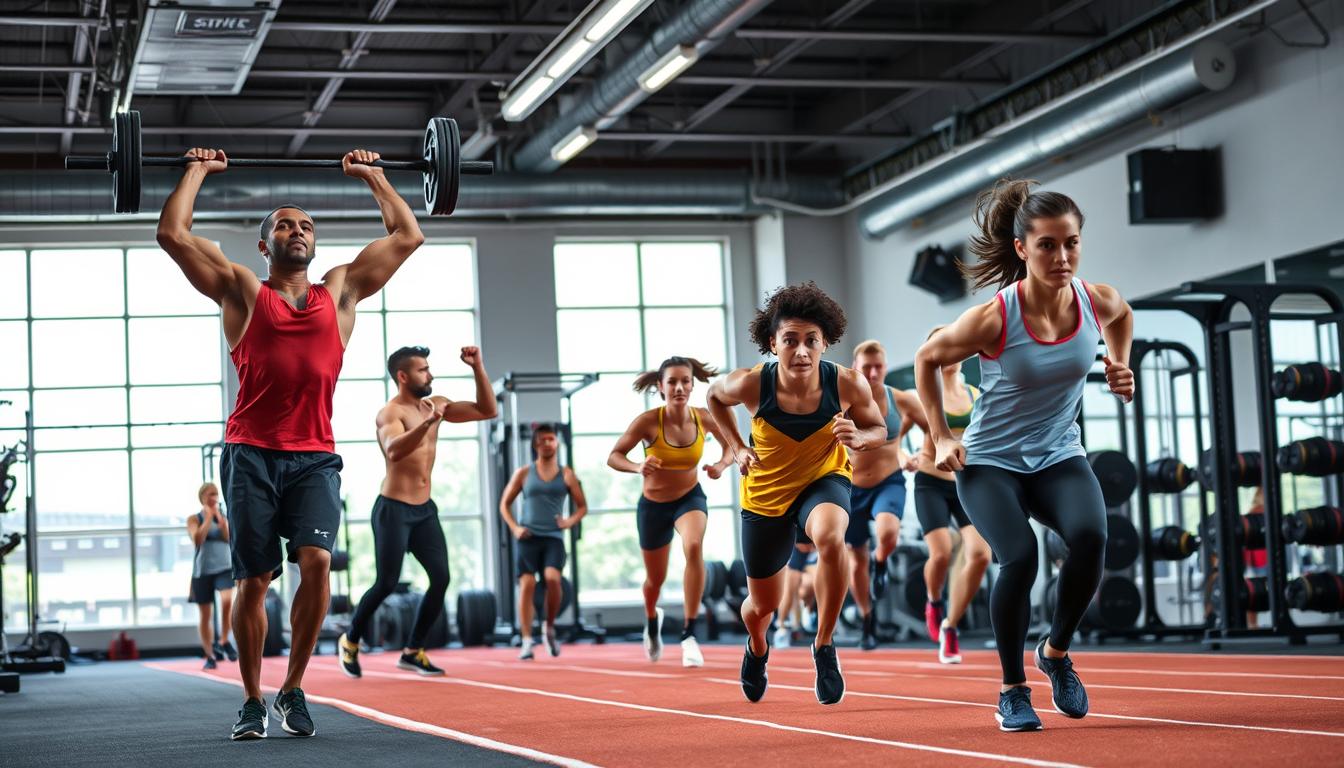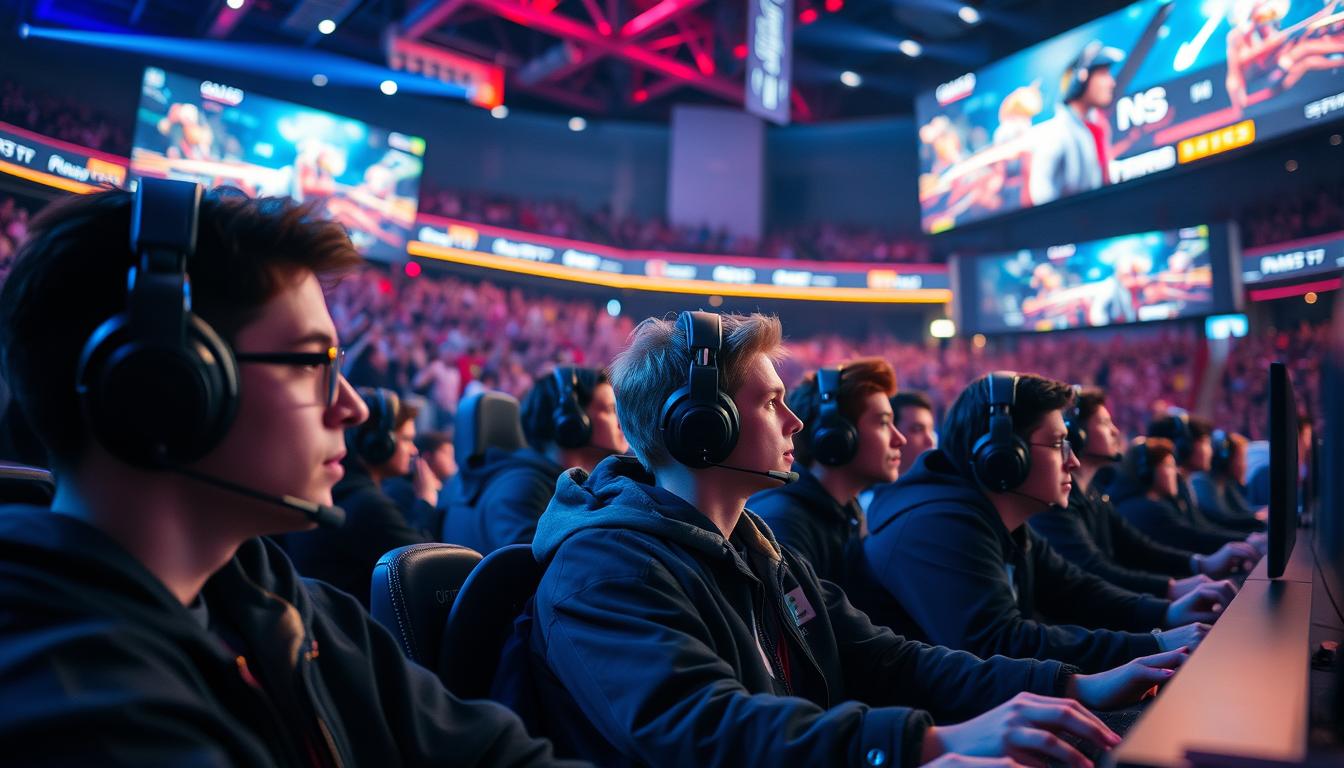We believe every athlete should reach their best, and athlete training programs help make that happen. These programs offer personalized coaching and advanced training methods. They help athletes in all sports, including esports and gaming, by improving reflexes and teamwork.
By using these programs, athletes can perform better, stay healthy, and get ahead of the competition. Our Forever ATHlete and Student ATHlete programs are designed for all ages. They focus on health, safety, and performance, helping athletes set and reach goals.
We also have special programs for athletes heading to college or the pros. Our training supports school and club sports, helping athletes grow in their sport.
Key Takeaways
- Athlete training programs provide personalized coaching and skill development for success.
- These programs benefit athletes in traditional sports and esports/gaming.
- Our programs offer training for adults and students aged 8-18, focusing on health and performance.
- We have special programs for athletes going to college or the pros.
- Training programs can reduce injury risk and boost athletic performance.
- Our programs work with medical experts for personalized return-to-play training.
Understanding Athlete Training Programs
We know that every athlete is different. They have their own strengths, weaknesses, and goals. That’s why athletic development plans need to be made just for them. They must consider the athlete’s fitness level, goals, and any health issues.
Creating a customized workout routine is key. It should include strength training, skill development, and mental preparation. This way, the athlete becomes well-rounded and ready to perform at their best.
- Initial assessments to find out what each athlete needs and wants
- Regular checks to see how they’re doing and make changes if needed
- A mix of strength training, skill work, and mental prep
By focusing on individual training and customized workout routines, athletes can see big improvements. It’s clear that a one-size-fits-all approach doesn’t work anymore. Instead, athletic development plans made just for each athlete are key to reaching their full ability.
Benefits of Customized Training Regimens
We know every athlete is different. They have unique strengths, weaknesses, and goals. That’s why tailored training plans are key for better performance and less injury risk. With elite athlete training programs, athletes get personal coaching. This leads to lasting results.
Custom training offers many benefits, including:
- Improved reaction time and decision-making skills
- Enhanced teamwork coordination and communication
- Increased strength and cardiovascular function
- Reduced risk of workout-related injuries
Experienced coaches provide personal attention and commitment. This helps athletes reach their goals. Performance enhancement programs are made just for them. They consider fitness level, goals, and nutrition. Athletes see big improvements, like a 15% muscle gain in three months.
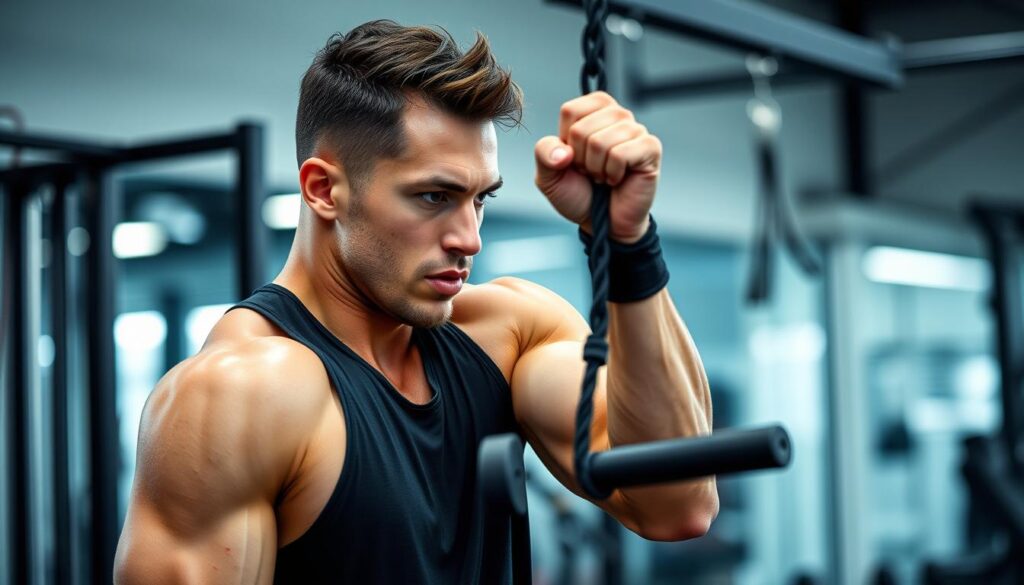
Maximizing Performance Gains
Custom training plans help athletes reach their best. They get personal workout plans, nutrition advice, and recovery tips. Working with a certified trainer boosts fitness goal achievement by 30%.
Reducing the Risk of Injury
Custom training also lowers injury risk. Coaches focus on proper techniques and injury prevention. Athletes see a 40% drop in injury risk with a tailored approach.
Types of Athlete Training Programs
There are many types of athlete training programs out there. Each one is designed to meet specific needs and goals. Professional sports coaching tailors these programs to help athletes reach their best.
These programs can be divided into three main categories. There are strength and conditioning programs, endurance training programs, and sport-specific training approaches.
Some common types of training programs include:
- Strength and conditioning programs, which focus on building muscular strength, power, and endurance
- Endurance training programs, which aim to improve cardiovascular fitness and stamina
- Sport-specific training approaches, which are tailored to the unique demands of a particular sport or activity
These programs can be mixed and matched to create a well-rounded training plan. With the right coaching and training, athletes can boost their performance, lower injury risks, and meet their goals.
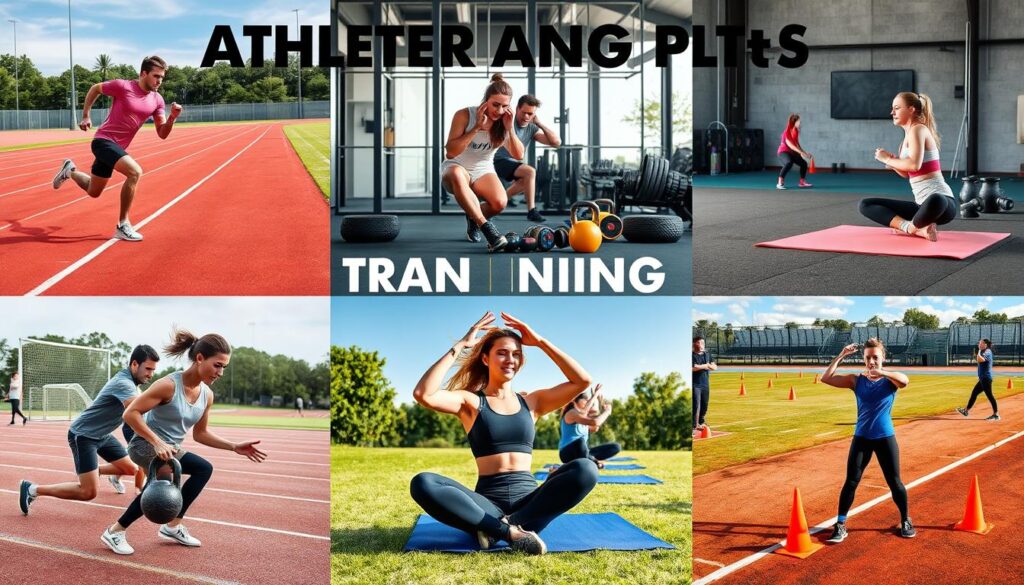
Finding the right balance in training and coaching is key to success. This balance supports each athlete’s unique needs and goals. By doing so, athletes can reach their full potentials and succeed in their sports.
| Type of Training Program | Description |
|---|---|
| Strength and Conditioning | Builds muscular strength, power, and endurance |
| Endurance Training | Improves cardiovascular fitness and stamina |
| Sport-Specific Training | Tailored to the unique demands of a particular sport or activity |
The Role of Nutrition in Athletic Training
When we plan our athletic development, nutrition is key. A good diet fuels our bodies, helps muscles grow, and speeds up recovery. It’s important to match our diet with our workout plans.
Nutrition greatly affects athletes’ performance and recovery. For instance, a special drink can make a 40 km cycling time trial 32–42 seconds faster. Also, eating right can delay tiredness by 20% and boost performance by 2%–3%. By focusing on nutrition, athletes can do better and reach their goals.
Here are some important nutrition tips for athletes:
- Eat 10–12 g of carbs per kg of body weight 36–48 hours before exercise.
- Have 1–4 g of carbs per kg of body weight 1–4 hours before exercise.
- Drink lots of water, more so during and after working out.
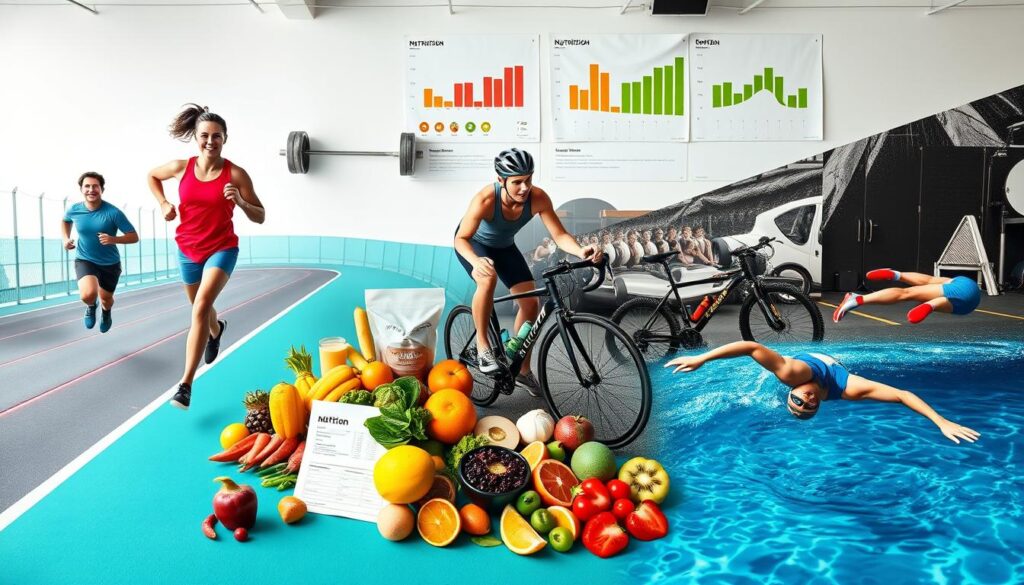
By making nutrition a priority, we can improve our training and meet our goals. Whether you’re a pro athlete or just starting, the right diet is essential for performance and health.
| Nutrient | Recommended Intake |
|---|---|
| Carbohydrates | 10–12 g/kg body mass per day |
| Protein | 1.2–2.3 g/kg body mass per day |
| Fluids | Plenty of fluids, more so during and after exercise |
Incorporating Technology into Training
We know how important technology is in elite athlete training. It helps athletes perform better and reach their goals. With the latest tools, athletes can get ahead and do their best. They use things like heart rate monitors and GPS to track their progress.
Technology in athlete training has many benefits. Here are a few:
- Real-time data and analytics for better performance and strategy
- Improved safety with equipment tracking
- Personalized coaching through virtual sessions
Tools like hydration sensors and altitude rooms help athletes get ready for different conditions. Coaching video systems and data zones let athletes review and improve their performance. Technology makes training better, safer, and more effective for athletes.
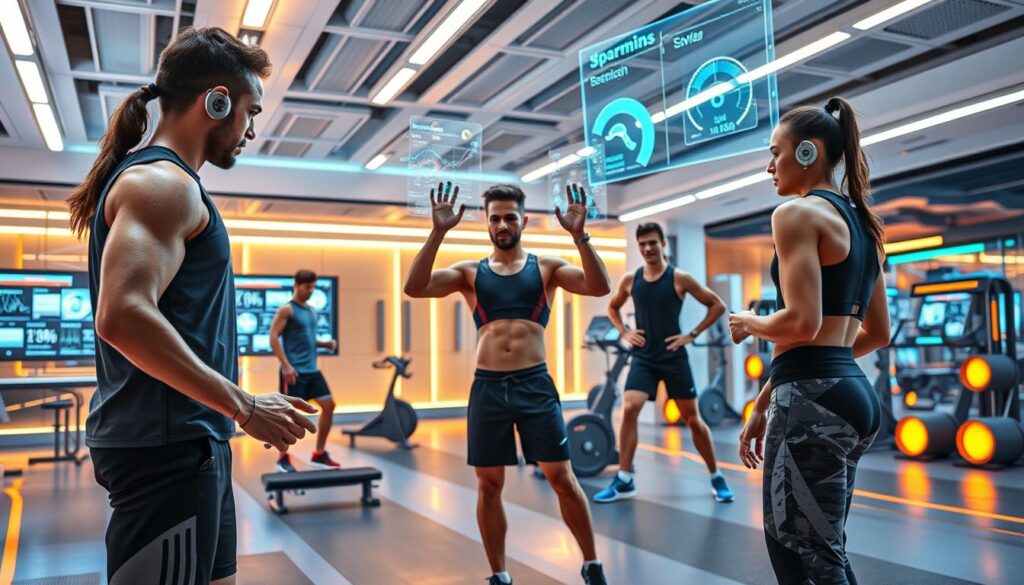
Exploring technology’s role in athlete training is key. It opens up new ways for athletes to reach their goals. With technology, athletes can unlock their full abilities and succeed in their sports.
| Technology | Benefits |
|---|---|
| Wearable fitness technology | Real-time data and analytics |
| Virtual coaching and training sessions | Personalized feedback and coaching |
| Hydration sensors and altitude training rooms | Improved player safety and preparation |
Setting Goals for Training Success
Setting realistic goals is key for athletes to stay motivated. In athlete training programs, goal-setting is vital. Athletes work with coaches to set SMART goals. SMART means specific, measurable, achievable, relevant, and time-bound.
Getting managers and employees involved in goal-setting boosts success. Athletes work with coaches to set goals that match their strengths and weaknesses. Regular reassessment of plans based on performance is critical. This helps avoid wasting effort.
Some key considerations for setting effective goals include:
- Setting specific and measurable objectives
- Creating a timeline for achieving goals
- Identifying obstacles and strategies to overcome them
- Regularly tracking progress and making adjustments as needed
By following these guidelines and working with professional sports coaching, athletes can set themselves up for success.
| Goal Type | Description |
|---|---|
| Short-term | Goals that can be achieved in a short period, such as improving a specific skill |
| Long-term | Goals that require a longer period to achieve, such as winning a championship |
Setting both short-term and long-term goals helps athletes stay focused. With the right mindset and support, athletes can achieve their goals and reach their full capacity.
Common Mistakes in Athlete Training
When we plan our athletic development, it’s key to know common mistakes. Overtraining is a big one. It can make us tired, lower our performance, and raise the chance of getting hurt. To dodge this, we should make sure to include rest and recovery days in our workout plans.
Another error is skipping recovery days. Our bodies need these days to fix and grow. By focusing on technique and listening to our bodies, we can steer clear of these mistakes and train better. Some common errors include:
- Overtraining: training too much or too hard without enough rest
- Neglecting recovery days: not giving our bodies time to rest and recover
- Failing to prioritize technique: not paying attention to proper form and execution
Knowing these mistakes and how to avoid them helps us make good plans and routines. This way, we can reach our goals.
Remember, consistency and patience are vital in athlete training. By sticking to our plans and giving our bodies time to adjust, we can progress steadily and meet our goals.
| Mistake | Consequence | Solution |
|---|---|---|
| Overtraining | Fatigue, decreased performance, increased risk of injury | Incorporate rest and recovery days into training schedule |
| Neglecting recovery days | Fatigue, decreased performance, increased risk of injury | Prioritize recovery days and allow body time to rest and recover |
| Failing to prioritize technique | Decreased performance, increased risk of injury | Focus on proper form and execution in training |
The Importance of Mental Conditioning
In the world of elite athlete training, it’s clear that success isn’t just about physical strength. Mental toughness plays a huge role too. It helps athletes build the mental resilience, focus, and confidence needed to excel.
Mental conditioning teaches athletes to handle stress and anxiety. It helps them grow, develop coping strategies, and overcome challenges. Techniques like visualization and self-talk boost confidence and improve performance. This way, athletes can gain an edge, feel better, and reach their goals.
Mental toughness includes self-confidence, positive thinking, and staying upbeat. Athletes can work on these skills through practice and training. Using strategies like coping, imagery, and relaxation can help them perform better and succeed in their sports.
With the help of sports psychologists, athletes can develop the mental strength needed for success. This is key in elite athlete training and performance enhancement programs.
Monitoring Progress and Performance
As we keep working to improve our athletic skills with athlete training programs, it’s key to watch our progress and how well we do. We track things like strength, endurance, and speed. This helps us see where we need to get better and fine-tune our training. With professional sports coaching, we can make plans that fit our unique needs and goals.
Keeping an eye on how we do is very important. It lets us make smart choices based on the data. By using tools like fitness tests and performance analysis, we learn a lot about our strengths and weaknesses. This helps us make better choices to boost our performance.
Some important things to track include:
- Strength, checked through one-rep max (1RM) tests
- Endurance, found by VO2 max tests
- Speed and agility, seen through sprint times and vertical jumps
By watching these metrics and getting help from professional sports coaching, we can make our training better. This helps us reach our goals and unlock our full athletic ability.
Finding the Right Resources and Support
As we wrap up our look at athlete training programs, it’s key to stress the need for the right support. Achieving top athletic performance means having the right guidance and tools around us.
Select the Best Training Programs
It’s vital to pick training programs that match our goals and needs. Look for programs with skilled coaches, effective training methods, and a history of success. This ensures we get the best chance to reach our athletic goals.
Engaging with Coaches and Trainers
Working with experienced coaches and trainers is also critical. They offer personalized help and support. This helps us improve our training, tackle our weaknesses, and overcome obstacles, leading us closer to our dreams.
Joining Training Groups or Communities
Lastly, joining training groups or communities is beneficial. Being around others who share our passion can motivate us. It helps us stay focused and committed, which is key to our success.
By accessing the right resources and support, we can reach our full athletic capacity. This opens the door to achieving greatness.
